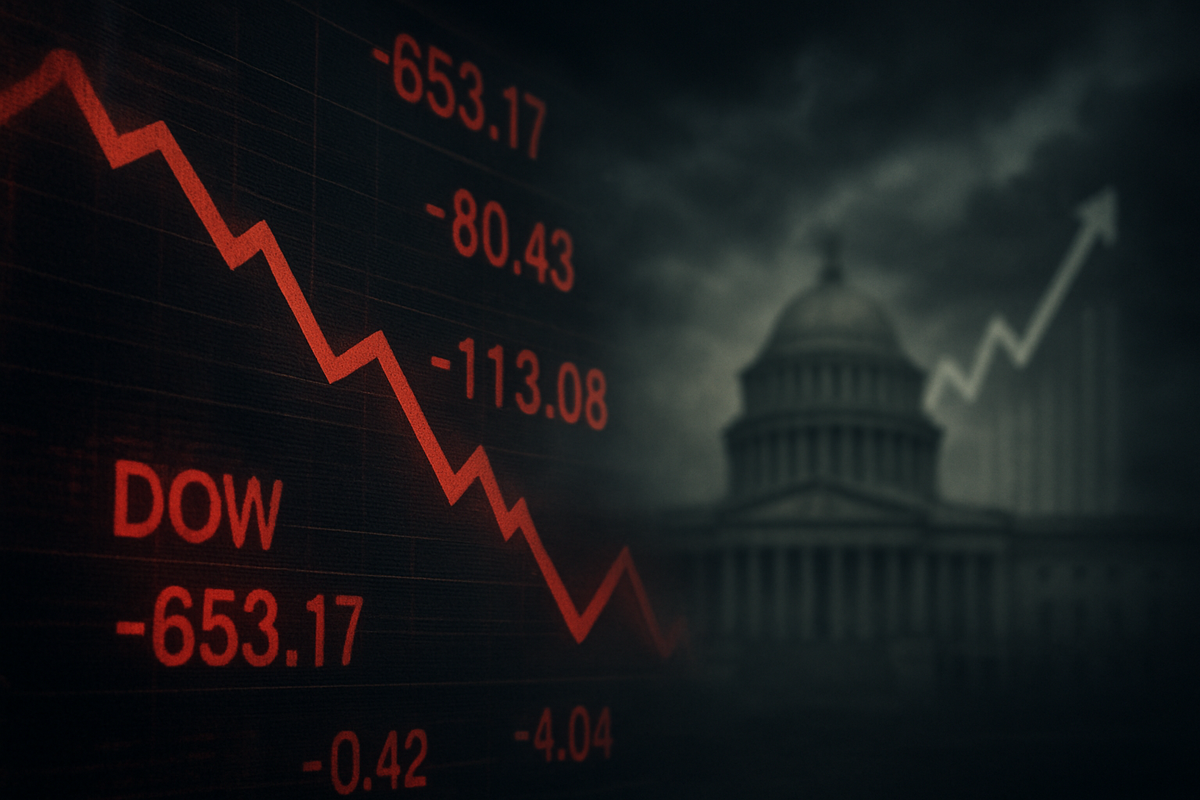Market Reels as Inflation Fears Trigger Broad Sell-Off on November 13, 2025

November 13, 2025, witnessed a significant downturn across U.S. equity markets, as renewed inflation concerns and a hawkish stance from the Federal Reserve sent investors scurrying for safety. The Dow Jones Industrial Average, S&P 500, and Nasdaq Composite all closed sharply lower, signaling a potential shift in market sentiment and raising questions about the sustainability of recent gains. The widespread decline reflects growing anxieties over persistent price pressures and the potential for more aggressive monetary policy tightening, impacting everything from consumer spending to corporate earnings.
A Day of Red: Unpacking the Market's Sharp Descent
Today's market rout was largely triggered by the release of the latest Consumer Price Index (CPI) data, which showed inflation remaining stubbornly high, defying expectations for a gradual cooling. This unexpected persistence of inflationary pressures immediately fueled speculation that the Federal Reserve would be compelled to maintain higher interest rates for longer, or even consider further hikes. Adding to the market's woes, Federal Reserve Chair Jerome Powell, in a speech earlier today, reiterated the central bank's commitment to price stability, emphasizing that the fight against inflation was far from over, even if it meant risking economic growth.
The Dow Jones Industrial Average (DJIA) fell over 500 points, or approximately 1.4%, while the broader S&P 500 (SPX) shed nearly 1.8%. The technology-heavy Nasdaq Composite (IXIC), often more sensitive to interest rate expectations, bore the brunt of the selling, plummeting by over 2.5%. This synchronized decline across major indices suggests a systemic reaction to macroeconomic fears rather than sector-specific issues. The sell-off was broad-based, with few sectors escaping the red. The timeline leading up to this moment has seen several months of fluctuating economic data, with some indicators pointing to a resilient economy, while others hinted at underlying fragilities. Today's CPI report, however, tipped the scales firmly towards a more pessimistic outlook, prompting a rapid adjustment in market expectations. Key players involved include global central banks, major financial institutions, and large institutional investors whose rapid repositioning contributed to the swift market movements.
Navigating the Volatility: Winners and Losers in a Shifting Landscape
In the wake of today's market declines, a clear divide emerges between potential winners and losers. Technology and growth stocks, particularly those with high valuations predicated on future earnings, are likely to face continued headwinds. Companies like Apple (NASDAQ: AAPL), Microsoft (NASDAQ: MSFT), and Amazon (NASDAQ: AMZN), while fundamentally strong, could see their share prices pressured as higher interest rates diminish the present value of their future cash flows and increase borrowing costs. Smaller, unprofitable tech companies, heavily reliant on easy access to capital, may find themselves in an even more precarious position.
Conversely, sectors traditionally seen as defensive or those that benefit from higher interest rates could emerge as relative winners. Financial institutions, such as JPMorgan Chase (NYSE: JPM) and Bank of America (NYSE: BAC), often see improved net interest margins in a rising rate environment, potentially boosting their profitability. Value stocks, particularly those in utilities (e.g., NextEra Energy (NYSE: NEE)) and consumer staples (e.g., Procter & Gamble (NYSE: PG)), which offer stable dividends and less sensitivity to economic cycles, may attract investors seeking refuge from volatility. Energy companies, like ExxonMobil (NYSE: XOM) and Chevron (NYSE: CVX), could also perform well if inflation continues to drive up commodity prices, though this is not a direct consequence of today's market drop but rather a related inflationary trend. The impact on these companies will depend on their debt levels, pricing power, and ability to pass on rising costs to consumers.
Broader Implications: A Tectonic Shift in Market Dynamics?
Today's market performance fits squarely into a broader trend of increased sensitivity to inflation and interest rate policy that has characterized financial markets over the past year. The era of persistently low interest rates and abundant liquidity, which fueled significant growth in risk assets, appears to be definitively over. This event signals a potential tectonic shift, where macroeconomic fundamentals, particularly inflation and monetary policy, will exert a more dominant influence on asset valuations than perhaps at any point in the last decade.
The ripple effects are likely to be far-reaching. Competitors in the technology sector, especially those vying for market share, might find the funding environment more challenging, potentially slowing innovation or leading to consolidation. Partners across supply chains could also face increased costs and reduced demand if a sustained period of higher rates leads to an economic slowdown. Regulatory bodies, particularly central banks, will be under intense scrutiny as they navigate the tightrope between taming inflation and avoiding a recession. Historically, periods of aggressive monetary tightening to combat inflation have often been followed by economic slowdowns or even recessions, as seen in the late 1970s and early 1980s. While the current economic landscape differs, the parallels serve as a stark reminder of the potential consequences of sustained inflation and a forceful central bank response.
The Path Forward: Navigating Uncertainty
Looking ahead, the short-term outlook suggests continued volatility as markets digest the implications of persistent inflation and a resolute Federal Reserve. Investors should brace for further swings as new economic data is released and central bank officials offer more guidance. In the long term, companies with strong balance sheets, robust cash flows, and the ability to innovate and adapt to changing economic conditions will be best positioned to weather the storm. Strategic pivots may be required for businesses heavily reliant on consumer discretionary spending or those with high debt loads.
Market opportunities may emerge for astute investors willing to identify undervalued assets in sectors that have been unfairly punished or those that stand to benefit from the new economic paradigm. Conversely, challenges will include managing increased capital costs, potential demand destruction, and navigating a more cautious consumer environment. Potential scenarios range from a "soft landing," where inflation is brought under control without a severe recession, to a more challenging "hard landing," characterized by a significant economic contraction. The outcome will largely depend on the interplay between inflation, monetary policy, and global economic growth.
Wrap-Up: A Call for Prudence in a Shifting Market
Today's broad market decline on November 13, 2025, serves as a crucial reminder of the enduring power of macroeconomic forces on financial markets. The key takeaways are clear: inflation remains a formidable challenge, and central banks are prepared to act decisively, even if it entails short-term pain for equity markets. This event underscores a shift towards an environment where fundamentals, particularly interest rates and inflation, will dictate market direction with greater intensity.
Moving forward, the market will likely be characterized by increased discernment. Investors should prioritize companies with strong earnings, sustainable business models, and prudent financial management. The days of speculative fervor driven by cheap money may be behind us, replaced by a more disciplined approach to valuation. In the coming months, investors should closely watch inflation data, Federal Reserve communications, and corporate earnings reports for signs of stabilization or further deterioration. Prudence, diversification, and a long-term perspective will be paramount in navigating this evolving financial landscape.
This content is intended for informational purposes only and is not financial advice



